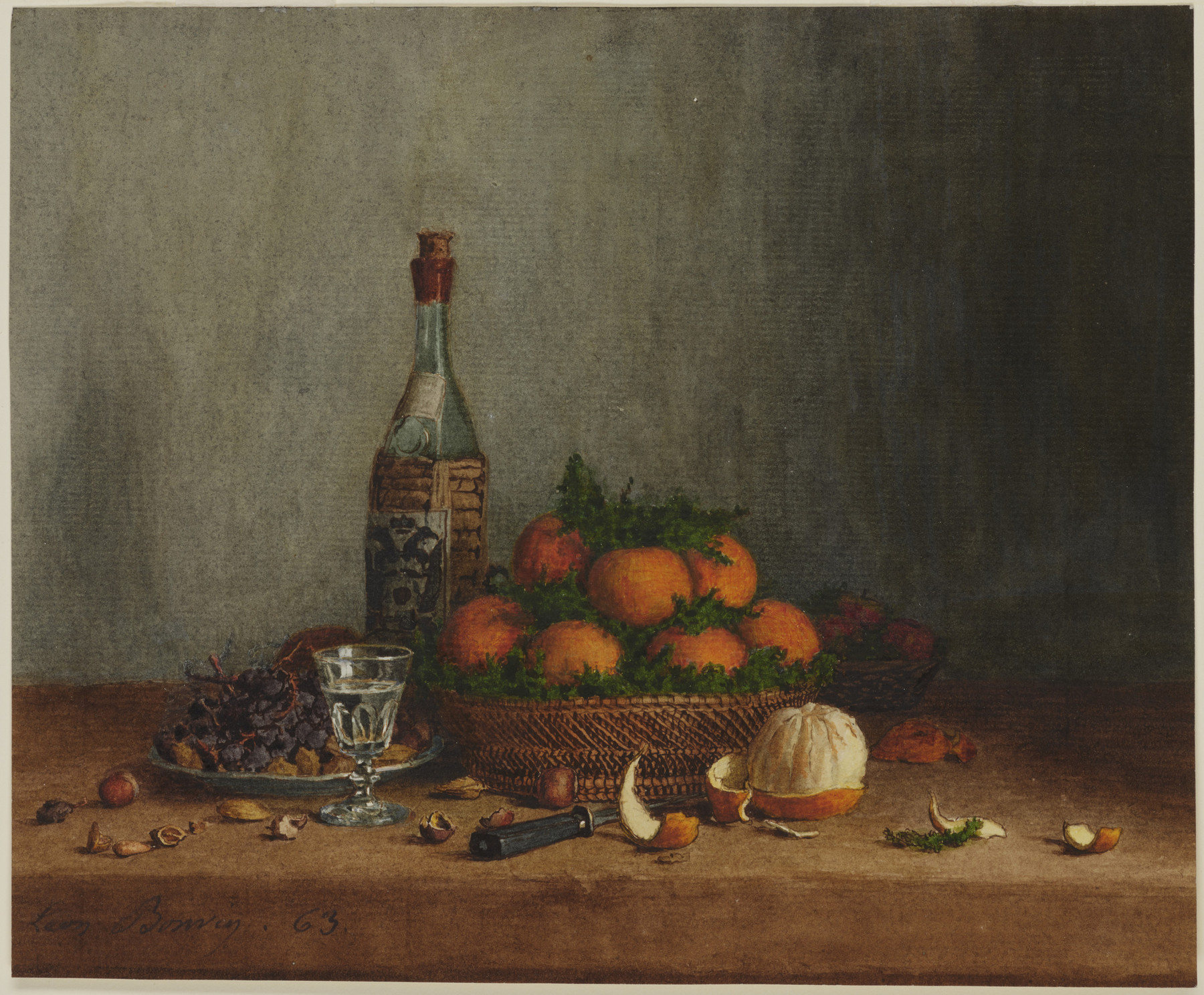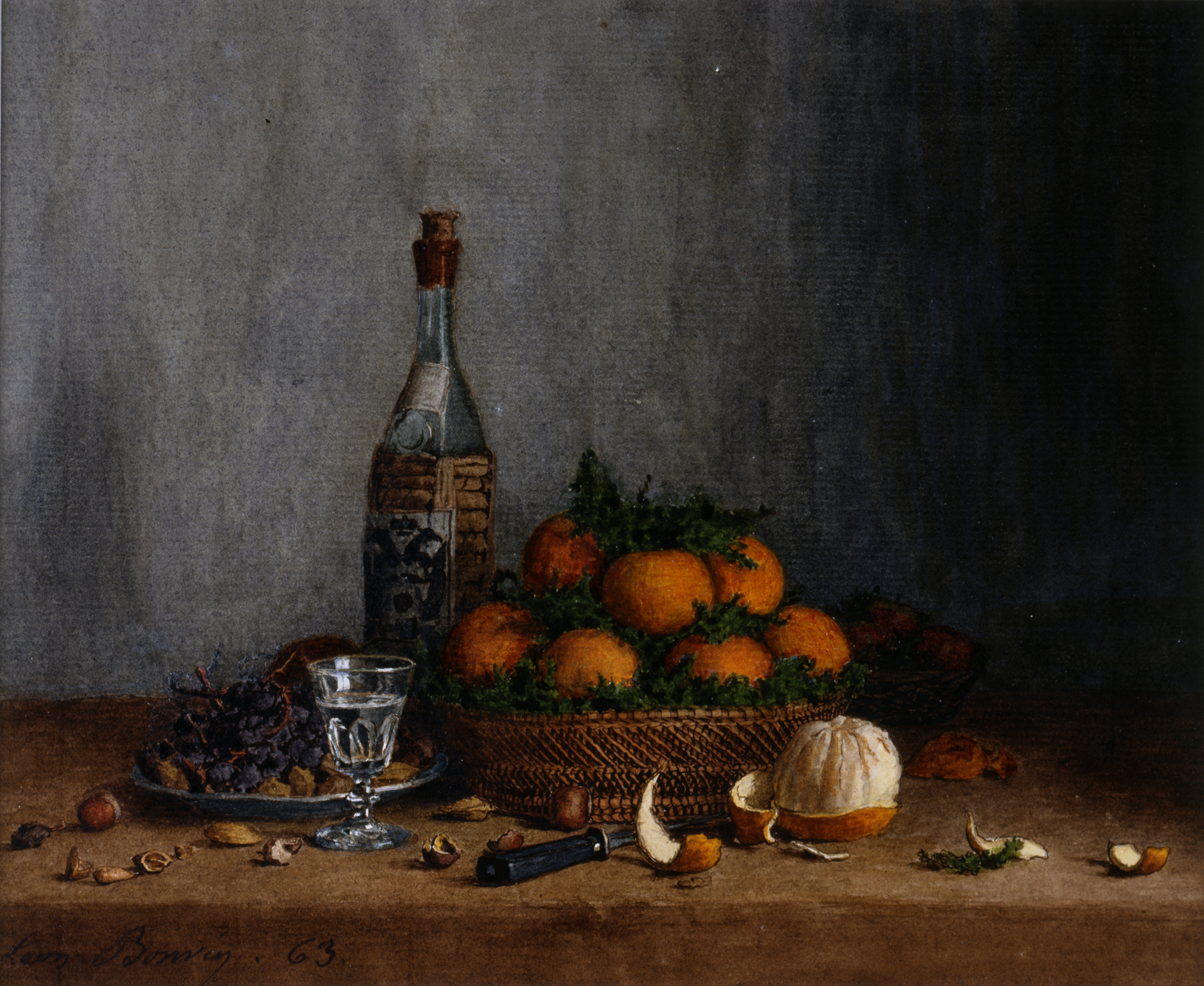Still Life with Basket of Oranges
(18th and 19th Centuries )
Léon Bonvin was born in Vaugirard, just outside Paris in 1834. Despite displaying great talent in the medium of watercolor he was largely unrecognized by his contemporaries. In 1866 he hanged himself at the age of 32, apparently due to financial difficulties. Working at his family's bar or "cabaret," he sketched and painted watercolors only in his spare moments, yet in the seven year period between 1859 and his death he created numerous exquisite still lifes of flowers and fruits, and subtle landscapes capturing fleeting atmospheric effects. There is evidence that, despite his rural home, Bonvin did have knowledge of the art world in Paris. His half-brother was the better known artist, François Bonvin. In addition Bonvin's still lifes show the influence of Jean-Siméon Chardin (1699-1779), whose work was undergoing a revival in the 1850s and 60s.
During the 19th century an appreciation of Bonvin's work was confined to a small circle of connoisseurs and collectors, most prominent among them William T. Walters, father of Henry Walters, founder of the Walters Art Museum. For much of the 19th century William displayed and stored his watercolors in a deluxe leather-bound album with a specially commissioned frontispiece and tailpiece by the renowned flower painter of the Lyon school, Jean-Marie Reignier (see WAM 37.1501 and 37. 1531). William's collection of Bonvin's work was acquired between 1862 and 1891, and eventually comprised 56 watercolors and one, rare oil; today, this is the largest collection of Bonvin's work in existence.
This watercolor shows Bonvin's knowledge Chardin, who worked around one hundred years prior to Bonvin's death. Bonvin includes a wicker basket, a knife, nuts, and brightly colored fruit packed in moss echoing Chardin's earlier composition. Bonvin's half-brother, François, may have been instrumental in interesting the artist in Chardin's work and linking him to the Parisian art scene more generally. In addition, Bonvin's café-bar was frequented by artists from Paris with whom Bonvin could have discussed art and art history.
Inscription
Provenance
Provenance (from the French provenir, 'to come from/forth') is the chronology of the ownership, custody, or location of a historical object. Learn more about provenance at the Walters.
William Hamilton Graham, Baltimore (through George A. Lucas as agent) [1]; William T. Walters, Baltimore, [date of acquisition unknown]; Henry Walters, Baltimore, 1894, by inheritance; Walters Art Museum, 1931, by bequest.
[1] In a diary entry for 10 February 1863 Lucas records "Bonvin to see me took fruit for Graham" "Bonvin 2 drawings apples oranges 30 fs." Given no other watercolors of oranges have been located by Bonvin dating from or before this date, it seems likely that William T. Walters later acquired this watercolor from his Baltimore neighbor.
Exhibitions
| 2022-2023 | Léon Bonvin (1834-1866). Fondation Custodia, Paris. |
| 2012 | Near Paris: The Watercolors of Léon Bonvin. The Walters Art Museum, Baltimore. |
| 2005-2006 | The Essence of Line: French Drawings from Ingres to Degas. The Walters Art Museum, Baltimore; Baltimore Museum of Art, Baltimore; Birmingham Museum of Art, Birmingham; Tacoma Art Museum, Tacoma. |
Conservation
| Date | Description | Narrative |
|---|---|---|
| 5/15/1972 | Treatment | re-housed |
| 1/1/2002 | Treatment | examined for exhibition; re-housed; mounted; cleaned; other |
Geographies
France (Place of Origin)
Measurements
H: 6 1/16 × W: 7 3/8 in. (15.4 × 18.7 cm)
Framed H: 21 1/4 × W: 16 1/4 × D: 1 5/16 in. (53.98 × 41.28 × 3.33 cm)
Credit Line
Acquired by William T. Walters
Location in Museum
Not on view
Accession Number
In libraries, galleries, museums, and archives, an accession number is a unique identifier assigned to each object in the collection.
In libraries, galleries, museums, and archives, an accession number is a unique identifier assigned to each object in the collection.
37.1524






